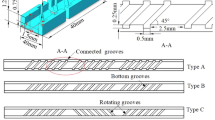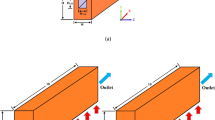Abstract
A new design of double-layered microchannel heat sinks, which combines wavy microchannels with porous vertical ribs, is proposed in this work. The flow and heat transfer behaviors of the new design are investigated via a three-dimensional solid–fluid conjugate heat sink model. The superiority of the new design is highlighted by comparing the new design with three existing double-layered designs under constant pumping power constraints. The three existing designs include a design with straight microchannels and solid-ribs, a design with straight microchannels and porous-ribs, and a design with wavy microchannels and solid-ribs. The results show that porous-ribs reduce the pressure drop across heat sinks, whereas wavy microchannels induce Dean vortices and enhance coolant mixing. In a low pumping power region of 0.005 to 0.01 W, the coolant inlet velocity is found to be the most dominant factor to determine the cooling capacity of heat sinks, whereas in a high pumping power region of 0.1 to 0.2 W, the coolant mixing becomes the dominant one. The new design has both wavy microchannels and porous-ribs, thus providing the best cooling capacity among the four double-layered heat sinks in the whole pumping power range of 0.005 to 0.2 W. The new design is further optimized by single-parameter analyses. It is found that with a fixed pumping power of 0.05 W as constraint, there is an optimal wavelength or an optimal amplitude of wavy units to achieve the lowest thermal resistance; however, the thermal resistance monotonously reduces with the increase in porous permeability or the decrease in quadratic drag factor.













Similar content being viewed by others
References
Fedorov AG, Viskanta R. Three-dimensional conjugate heat transfer in the microchannel heat sink for electronic packaging. Int J Heat Mass Transf. 2000;43(3):399–415.
Tuckerman DB, Pease RFW. High-performance heat sinking for VLSI. IEEE Electron Device Lett. 1981;2(5):126–9.
Wang ZH, Wang XD, Yan WM, Duan YY, Lee DJ, Xu JL. Multi-parameters optimization for microchannel heat sink using inverse problem method. Int J Heat Mass Transf. 2011;54(13–14):2811–9.
Vafai K, Zhu L. Analysis of two-layered micro-channel heat sink concept in electronic cooling. Int J Heat Mass Transf. 1999;42(12):2287–97.
Leng C, Wang XD, Wang TH, Yan WM. Multi-parameter optimization of flow and heat transfer for a novel double-layered microchannel heat sink. Int J Heat Mass Transf. 2015;84:359–69.
Wu JM, Zhao JY, Tseng KJ. Parametric study on the performance of double-layered microchannels heat sink. Energy Convers Manag. 2014;80:550–60.
Ahmed HE, Ahmed MI, Seder IM, Salman BH. Experimental investigation for sequential triangular double-layered microchannel heat sink with nanofluids. Int Commun Heat Mass Transf. 2016;77:104–15.
Shen H, Jin X, Zhang F, Xie G, Sunden B, Yan H. Computational optimization of counter-flow double-layered microchannel heat sinks subjected to thermal resistance and pumping power. Appl Therm Eng. 2017;121:180–9.
Lu B, Meng WJ, Mei F. Experimental investigation of Cu-based, double-layered, microchannel heat exchangers. J Micromech Microeng. 2013;23(3):035017.
Kleiner MB, Kuhn SA, Haberger K. High performance forced air cooling scheme employing microchannel heat exchangers. Trans Compon Packag Manuf Technol: Part A. 1995;18(4):795–804.
Jang SP, Choi SU. Cooling performance of a microchannel heat sink with nanofluids. Appl Therm Eng. 2006;26(17–18):2457–63.
Wang XD, An B, Lin L, Lee DJ. Inverse geometric optimization for geometry of nanofluid-cooled microchannel heat sink. Appl Therm Eng. 2013;55(1–2):87–94.
Wang XD, An B, Xu JL. Optimal geometric structure for nanofluid-cooled microchannel heat sink under various constraint conditions. Energy Convers Manag. 2013;65:528–38.
Khodabandeh E, Rozati SA, Joshaghani M, Akbari OA, Akbari S, Toghraie D. Thermal performance improvement in water nanofluid/GNP–SDBS in novel design of double-layer microchannel heat sink with sinusoidal cavities and rectangular ribs. J Therm Anal Calorim. 2019;136(3):1333–45.
Sajid MU, Ali HM, Sufyan A, Rashid D, Zahid SU, Rehman WU. Experimental investigation of TiO2–water nanofluid flow and heat transfer inside wavy mini-channel heat sinks. J Therm Anal Calorim. 2019;137:1279–94.
Leng C, Wang XD, Yan WM, Wang TH. Heat transfer enhancement of microchannel heat sink using transcritical carbon dioxide as the coolant. Energy Convers Manag. 2016;110:154–64.
Li Z, Tao WQ, He YL. A numerical study of laminar convective heat transfer in microchannel with non-circular cross-section. Int J Therm Sci. 2006;45:1140–8.
Farhanieh B, Sunden B. Three-dimensional laminar flow and heat transfer in the entrance region of trapezoidal ducts. Int J Numer Meth Fluids. 1991;13(5):537–56.
Hasan MI, Rageb AA, Yaghoubi M, Homayoni H. Influence of channel geometry on the performance of a counter flow microchannel heat exchanger. Int J Therm Sci. 2009;48(8):1607–18.
Hung TC, Huang YX, Yan WM. Thermal performance analysis of porous-microchannel heat sinks with different configuration designs. Int J Heat Mass Transf. 2013;66:235–43.
Che Z, Wong TN, Nguyen NT, Yang C. Three dimensional features of convective heat transfer in droplet-based microchannel heat sinks. Int J Heat Mass Transf. 2015;86:455–64.
Ghani IA, Kamaruzaman N, Sidik NAC. Heat transfer augmentation in a microchannel heat sink with sinusoidal cavities and rectangular ribs. Int J Heat Mass Transf. 2017;108:1969–81.
Li YF, Xia GD, Ma DD, Jia YT, Wang J. Characteristics of laminar flow and heat transfer in microchannel heat sink with triangular cavities and rectangular ribs. Int J Heat Mass Transf. 2016;98:17–28.
Shafeie H, Abouali O, Jafarpur K, Ahmadi G. Numerical study of heat transfer performance of single-phase heat sinks with micro pin-fin structures. Appl Therm Eng. 2013;58:68–76.
Zhai Y, Xia G, Chen Z, Li Z. Micro-PIV study of flow and the formation of vortex in micro heat sinks with cavities and ribs. Int J Heat Mass Transf. 2016;98:380–9.
Xia G, Ma D, Zhai Y, Li Y, Liu R, Du M. Experimental and numerical study of fluid flow and heat transfer characteristics in microchannel heat sink with complex structure. Energy Convers Manag. 2015;105:848–57.
Ma DD, Xia GD, Li YF, Wang JJ. Effects of structural parameters on fluid flow and heat transfer characteristics in microchannel with offset zigzag grooves in sidewall. Int J Heat Mass Transf. 2016;101:427–35.
Ma DD, Xia GD, Li YF, Wang JJ. Design study of micro heat sink configurations with offset zigzag channel for specific chips geometrics. Energy Convers Manag. 2016;127:160–9.
Lin L, Zhao J, Lu G, Wang XD, Yan WM. Heat transfer enhancement in microchannel heat sink by wavy channel with changing wavelength/amplitude. Int J Therm Sci. 2017;118:423–34.
Lu G, Zhao J, Lin L, Wang XD, Yan WM. A new scheme for reducing pressure drop and thermal resistance simultaneously in microchannel heat sinks with wavy porous fins. Int J Heat Mass Transf. 2017;111:1071–8.
Sui Y, Lee PS, Teo CJ. An experimental study of flow friction and heat transfer in wavy microchannels with rectangular cross section. Int J Therm Sci. 2011;50(12):2473–82.
Sui Y, Teo CJ, Lee PS, Chew YT, Shu C. Fluid flow and heat transfer in wavy microchannels. Int J Heat Mass Transf. 2010;53(13–14):2760–72.
Xie G, Chen Z, Sunden B, Zhang W. Numerical predictions of the flow and thermal performance of water-cooled single-layer and double-layer wavy microchannel heat sinks. Numer Heat Transf Part A: Appl. 2013;63(3):201–25.
Shui L, Huang B, Dong K, Zhang C. Investigation of heat transfer and flow characteristics in fractal tree-like microchannel with steam cooling. ASME Turbo Expo 2017: Turbomachinery Technical Conference and Exposition. Volume 5A: Heat Transfer. Charlotte; 2017.
Ghaedamini H, Salimpour MR, Mujumdar AS. The effect of svelteness on the bifurcation angles role in pressure drop and flow uniformity of tree-shaped microchannels. Appl Therm Eng. 2011;31(5):708–16.
Xu S, Li Y, Hu X, Yang L. Characteristics of heat transfer and fluid flow in a fractal multilayer silicon microchannel. Int Commun Heat Mass Transf. 2016;71:86–95.
Xu S, Wang W, Fang K, Wong CN. Heat transfer performance of a fractal silicon microchannel heat sink subjected to pulsation flow. Int J Heat Mass Transf. 2015;81:33–40.
Yu XF, Zhang CP, Teng JT, Huang SY, Jin SP, Lian YF, Cheng CH, Xu TT, Chu JC, Chang YJ, Dang T, Greif R. A study on the hydraulic and thermal characteristics in fractal tree-like microchannels by numerical and experimental methods. Int J Heat Mass Transf. 2012;55(25–26):7499–507.
Leng C, Wang XD, Wang TH, Yan WM. Fluid flow and heat transfer in microchannel heat sink based on porous fin design concept. Int Commun Heat Mass Transf. 2015;65:52–7.
Li XY, Wang SL, Wang XD, Wang TH. Selected porous-ribs design for performance improvement in double-layered microchannel heat sinks. Int J Therm Sci. 2019;137:616–26.
Wang SL, Li XY, Wang XD, Lu G. Flow and heat transfer characteristics in double-layered microchannel heat sinks with porous fins. Int Commun Heat Mass Transf. 2018;93:41–7.
Hetsroni G, Gurevich M, Rozenblit R. Sintered porous medium heat sink for cooling of high-power mini-devices. Int J Heat Fluid Flow. 2006;27(2):259–66.
Choi CH, Ulmanella U, Kim J, Ho CM, Kim CJ. Effective slip and friction reduction in nanograted superhydrophobic microchannels. Phys Fluids. 2006;18:087105.
Acknowledgements
This study was partially supported by the State Key Program of National Natural Science of China (No. 51936004), the National Science Fund for Distinguished Young Scholars of China (No. 51525602), Science Fund for Creative Research Groups of the National Natural Science Foundation of China (No. 51821004), and the Fundamental Research Funds for the Central Universities (No. 2017ZZD006).
Author information
Authors and Affiliations
Corresponding author
Additional information
Publisher's Note
Springer Nature remains neutral with regard to jurisdictional claims in published maps and institutional affiliations.
Rights and permissions
About this article
Cite this article
Wang, SL., Chen, LY., Zhang, BX. et al. A new design of double-layered microchannel heat sinks with wavy microchannels and porous-ribs. J Therm Anal Calorim 141, 547–558 (2020). https://doi.org/10.1007/s10973-020-09317-3
Received:
Accepted:
Published:
Issue Date:
DOI: https://doi.org/10.1007/s10973-020-09317-3




